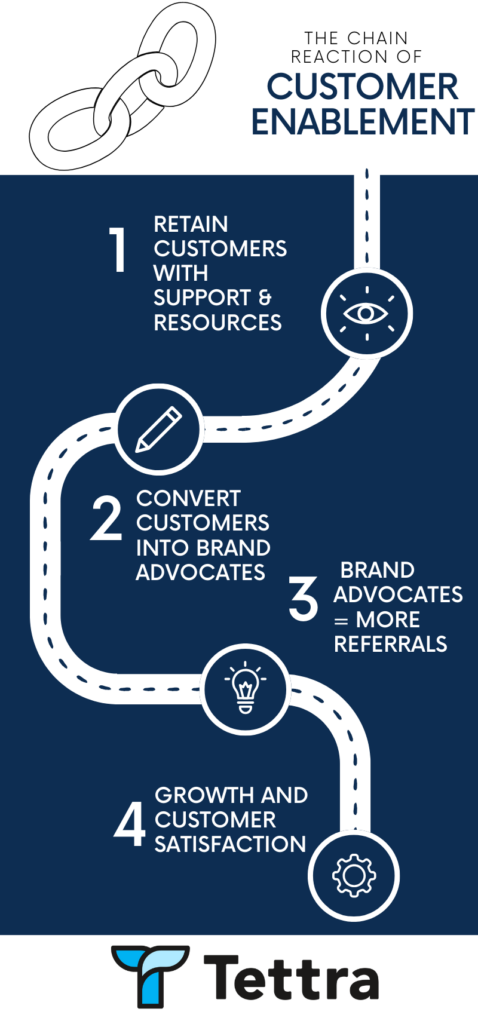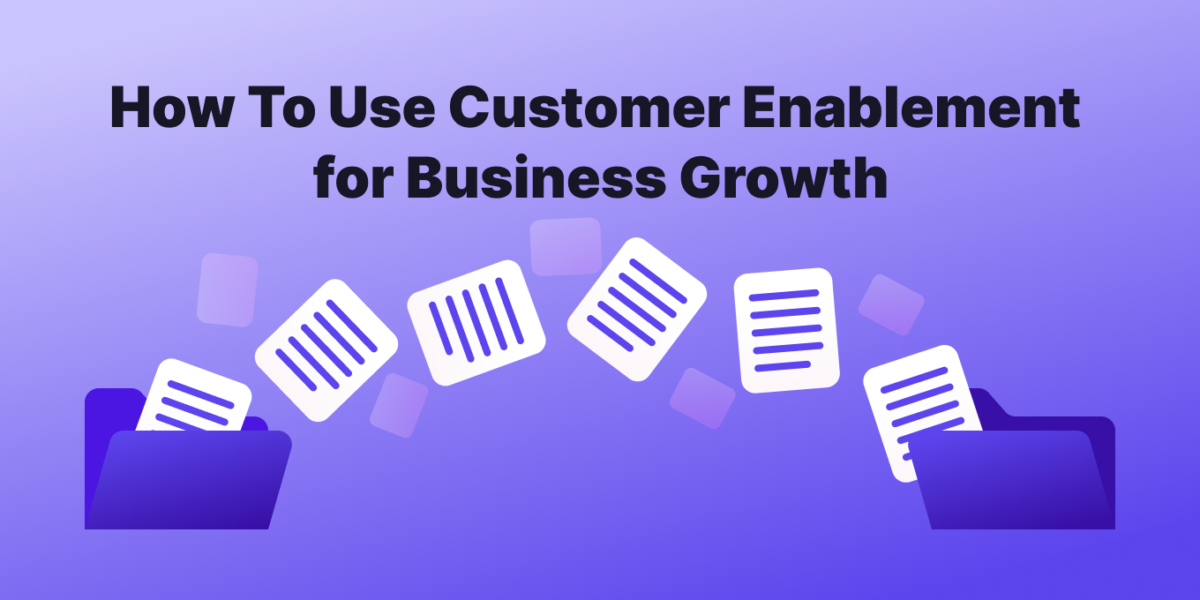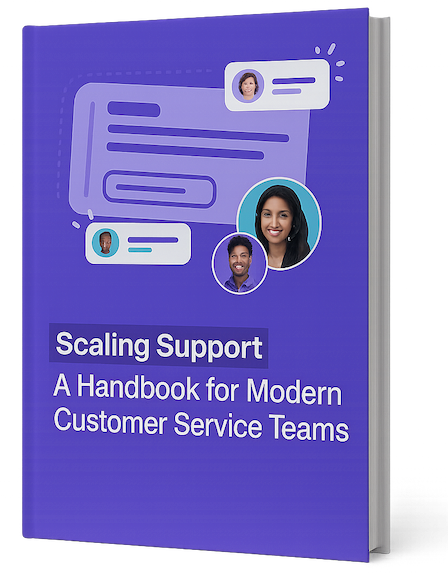What is Customer Enablement?
Customer Enablement represents a pivotal strategy in modern business operations, aimed at empowering customers with the knowledge, skills, and resources they need to effectively use a product or service.
This process goes beyond basic customer service; it involves actively assisting customers in realizing the full potential of their purchases, thus driving success for both the customer and the business.
The Chain Reaction of Customer Enablement
Customer enablement plays a crucial role in enhancing customer relationships and driving business growth.
Customer enablement serves as a cornerstone for nurturing robust customer relationships and fostering business growth. Here’s a closer look at its benefits:
- Customer Retention: Effective customer enablement strategies significantly enhance customer retention. By providing customers with the support and resources they need, businesses can foster loyalty and reduce churn.
- Converting Customers into Brand Advocates: Satisfied customers often become enthusiastic brand advocates, referring new customers and positively impacting the brand’s reputation.
- Increased Referrals: A direct outcome of high customer satisfaction is an increase in referrals, bringing new business opportunities with minimal investment.
- Growth and Customer Satisfaction: By ensuring that customers can maximize the value from their purchases, businesses not only boost customer satisfaction but also pave the way for greater business growth.
That is a nice chain reaction of customer satisfaction.

How Customer Feedback Helps Your Customer Enablement
The next step is to gather and analyze customer feedback. It is integral to refining customer enablement strategies. This feedback provides businesses with direct insights into customer needs and experiences.
1. Collect Customer Feedback
The importance of collecting customer feedback cannot be overstated.
Tools like Net Promoter Score (NPS) surveys, support tickets, and community forums are invaluable for this purpose.
NPS has spread rapidly because it gives you a quick snapshot of customer perceptions.
Here’s how Fred Reicheld (who created the metric) described it in the Harvard Business Review:
“It gauges how consistently a firm turns customers into advocates, by tracking and analyzing three segments: promoters, customers who are so pleased with their experience that they recommend your brand to others; passives, customers who feel they got what they paid for but nothing more and who are not loyal assets with lasting value; and detractors, customers who are disappointed with their experience and harm the firm’s growth and reputation.”
They provide businesses with a wealth of insights into customer opinions and experiences. By integrating this feedback, companies can enhance their customer support, success, marketing, and sales strategies, ultimately leading to improved customer satisfaction and business outcomes.
2. Analyze Customer Feedback
Analyzing customer feedback involves a deep dive into the data collected through various means. Go back to those NPS surveys and comment boxes or reviews left about your product.
The goal is to discern patterns and trends that indicate areas of strength and weakness in customer enablement and education initiatives.
By methodically analyzing this feedback, businesses can tailor their services to better meet customer needs and enhance the overall user experience.
3. Implement Changes Based on Customer Feedback
Implementing changes based on customer feedback is a dynamic process. It starts with a thorough review of the feedback, identifying common themes or issues, and then devising an action plan to address these.
Utilizing NPS survey data and customer comments helps in prioritizing changes that will most positively impact customer satisfaction.
Collaborating with different teams within the organization is essential to ensure these changes are effectively communicated and implemented.
How Your Customer Success Team Fits in Customer Enablement
The customer success team is a linchpin in the machinery of customer enablement, playing a multifaceted role in supporting and empowering customers. Here’s how it works.
Role of the Customer Success Team in Customer Enablement
The customer success team is critical in enabling customers to achieve success with a company’s products or services.
They offer support, gather valuable insights into customer behavior and needs, and contribute significantly to building a positive brand reputation. By empowering customers, the customer success team directly drives business growth through improved customer enablement.
The Role of The Customer Success Team
The customer success team is vital in driving customer enablement, ensuring that customers achieve success with the company’s products or services.
Customer Success Enablement
Customer success enablement is about equipping the customer success team with the tools, resources, and training they need to effectively support customers. This includes ongoing education, access to knowledge bases, and the ability to leverage customer feedback for continuous improvement.
Adding in a Customer Success Manager
The customer success manager is key in this process. They act as a bridge between the customer and the company, personalizing the customer experience, understanding customer needs, and ensuring that customers realize the full value of their purchase.
Best Practices for Building an Effective Customer Success Team
Building an effective customer success team involves defining clear roles and responsibilities, selecting team members judiciously, and establishing metrics for measuring success. Collaboration between customer success and other departments is crucial for a holistic approach to customer enablement.
This synergy ensures that the team is well-equipped to address customer needs comprehensively.
Tips for Optimizing the Performance of a Customer Success Team
Optimizing a customer success team’s performance includes strategies like proactive issue resolution, comprehensive onboarding assistance, regular check-ins with customers, and implementing systems for customer celebration and rewards. These practices ensure that customers feel continually supported and valued.
Now Build a Customer Enablement Strategy
A well-structured customer enablement strategy is foundational to long-term customer satisfaction and business growth.
Components of an Effective Strategy for Enabling Customers
An effective customer enablement strategy comprises several core components, each playing a crucial role in empowering customers.
These include understanding the customer journey, offering personalized support, providing easy access to information and resources, and regular engagement.
Implementing this strategy involves a systematic approach, considering each step’s impact on the overall customer experience.
Think of customer journey stages, delivery channels, and the method needed for implementation. Outlining specific actions, resources, goals, metrics, and a timeline is critical for the strategy’s success.
Customer Journey
Understanding the customer journey, from onboarding to ongoing support, is pivotal. Customer success managers play a crucial role in each stage, personalizing the user experience and ensuring continuous engagement.
If you’re unfamiliar with customer success managers, they are one of the fastest growing roles at tech companies. Research from Harvard Business Review found that in 2019, more than 40% of 100+ high-tech companies surveyed had a customer success manager.
Regular check-ins are essential to ensure customers are not just using the products but are also achieving their goals with them.
Implementing an effective customer enablement strategy is a comprehensive process that requires a deep understanding of customer needs, an effective feedback system, a dedicated customer success team, and a long-term strategic approach.
When executed well, it leads to increased customer satisfaction, retention, and ultimately, business growth.
Integrate Your Sales Enablement into Customer Success
Sales enablement plays a crucial role in this ecosystem. It involves providing the sales team with the resources, tools, and training they need to sell more effectively. By aligning sales enablement with customer enablement, businesses can ensure a seamless experience from the first customer interaction through to ongoing support and success.
Components of an Effective Enablement Strategy
An effective strategy includes understanding the customer journey, offering personalized support, providing easy access to information, and ensuring regular engagement. Implementing this strategy requires a systematic approach, focusing on the impact on customer experience and sales effectiveness.
Creating a Successful Enablement Strategy
Creating a successful enablement strategy involves a systematic approach incorporating best practices in both customer and sales enablement. This means empowering customers and the sales team alike, ensuring their success and loyalty.
Developing a Long-Term Enablement Approach
Developing a long-term approach requires considering customer journey stages, delivery channels, and systematic implementation. This involves outlining specific actions, resources, goals, metrics, and timelines.
Customer Training as a Component of Enablement
Customer training is an integral part of enablement, providing customers with the knowledge and skills needed to fully utilize a product or service. This training can be delivered through various methods, including online courses, webinars, and in-person sessions.
How Tettra Helps Your Customer Enablement
An internal knowledge base like Tettra plays a pivotal role in having the right information that you need when you need it. As a central source of truth for documentation and information, Tettra ensures your customer success and support teams have the most accurate info. Here’s why it’s indispensable:
- Centralized Information Hub:
- Tettra serves as a single source of truth for all customer-related information.
- It eliminates the confusion and inefficiency that comes with scattered data.
- Efficient Onboarding:
- Provides comprehensive resources for new customers, facilitating smoother onboarding.
- Helps in setting clear expectations and understanding of the product or service.
- Empowering Customer Support:
- Enables support teams to quickly access relevant information, enhancing response times and accuracy.
- Acts as a reference point for handling FAQs and complex queries.
- Consistent Information Delivery:
- Ensures that all customers receive uniform and accurate information.
- Helps maintain consistency in messaging and guidelines shared with customers.
- Continuous Learning and Development:
- Offers a platform for customers to learn and grow with the product.
- Regularly updated content keeps customers informed about new features and best practices.
- Feedback Integration and Improvement:
- Facilitates the collection and integration of customer feedback into knowledge base content.
- Allows for continuous improvement in the resources provided, based on customer needs and experiences.


